More True Tales of Tribeca Buildings
The History of Tribeca Buildings database—compiled from Tom Miller’s posts at Daytonian in Manhattan—has six more entries on the properties below. (Click the address to read the full text.) If you enjoy these, and you will, then you should definitely check out his website, which also has write-ups about buildings all over the island. And don’t miss his book, Seeking New York: The Stories Behind the Historic Architecture of Manhattan—One Building at a Time.
·························
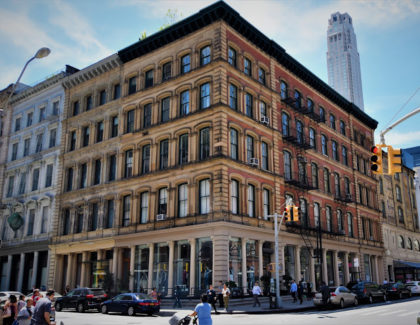 150-152 DUANE
150-152 DUANE
William S. Mount opened his new business in the building on September 20, 1876. A stark departure from the dry goods firms, he dealt in “Turkish Goods.” American relations with the Ottoman Empire had been shaky at best until a treaty was signed in 1862. By now merchants like Mount were importing an array of exotic goods. Listed in his opening announcement were “Turkish rugs, Persian Rugs, embroidered table covers, neck ties; embroidered chair covers jackets; embroidered cushion covers, slippers, and a variety of other articles.” The following decade would continue to see a more diverse list of tenants. In 1882, S. Moorhouse & Co., importers and wholesalers of “staple and fancy” groceries, was in the building; and around 1884 Edwin C. Burt & Co., makers of ladies’ and children’s fine shoes, moved in from No. 93 Thomas Street. It was the first sign of the neighborhood’s change from the dry goods to shoe district.
·························
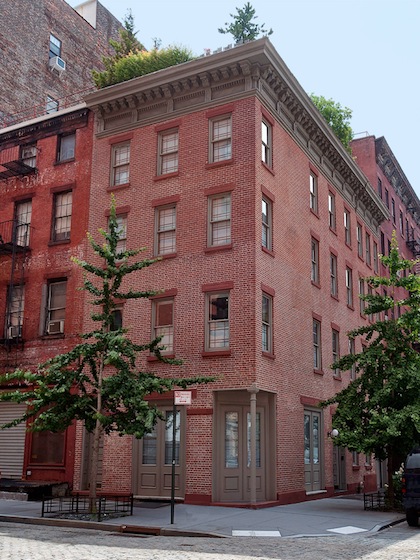 452 GREENWICH
452 GREENWICH
By the mid-1840s, 452 Greenwich was being operating as a boarding house; home to respectable tenants like S. A. Jenkins. Jenkins was the sole teacher in Public School 37, almost directly across the street at No. 457 Greenwich Street. Another boarder that year was Martha E. Walker. She had left her husband, Thomas, who was verbally abusive and unfaithful. Her animosity was apparent in a letter she wrote from the Greenwich Street house on January 28, 1847 asking for the return of her miniature portrait. She said in part: “I am happy, and will continue so in spite of all that you can do. I have plenty of friends, although you have said I was so vile… Your miniature I enclose, and again demand mine; the likeness of a villain I feel no inclination to retain. Your face brings only the remembrance of your baseness to my mind.” Martha’s description of her husband as a villain was apparently not overly dramatic. He was tried on June 4, 1849, for her murder.
·························
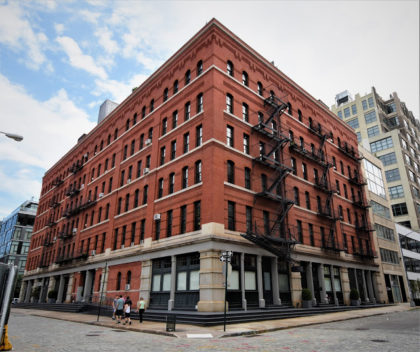 461-469 GREENWICH
461-469 GREENWICH
465 Greenwich was filled with workers on the afternoon of August 11, 1896, when an explosion occurred on the first floor. By 3 p.m., the blaze had grown to a four-alarm inferno, spreading to No. 467, occupied by distillers, candy factories, and an umbrella manufacturer. The rapid spread of the fire cut off the escape of scores of workers. The Salt Lake Herald, on August 12, reported, “The firemen who first reached the scene of the conflagration say they saw a number of men at the windows appealing for help, but before any attempt at rescue could be made they fell back exhausted by the heat and smoke and all are supposed to have perished in the flames.” Other workers in nearby factories watched in horror. “One young girl, it was said, was seen to approach one of the windows in the burning structure. Before aid could reach her she had fallen back into the seething mass of flames waiting to swallow her up.” William Gray and James Muller, both workers of the Warren firm, made it to a fire escape, but were trapped and burned to death. Their “charred bodies” remained there for hours while firefighters battled the blaze.
·························
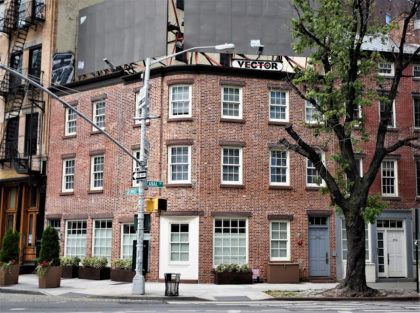 480 GREENWICH / 502 CANAL
480 GREENWICH / 502 CANAL
In 1909, George Hayunga addressed the annual meeting of the Lutheran Inner Mission Society, where the Times reported he “urged the need of a Lutheran hospital to cost from $50,000 to $60,000, a Lutheran dispensary to maintain which $5,000 yearly would be necessary, and a district medical board.” By March, 1911, the Society of the Lutheran Hospital had been formed, and its constitution adopted. But as the time-consuming process of acquiring land, planning the facility, and other intricate details were ironed out, Hayunga seems to have taken matters into his own hands. The 1914 New York Charities Directory listed the Lutheran Hospital of Manhattan at No. 502 Canal Street. The directory described the facility as being “for care and relief of ill and indigent poor of the Borough of Manhattan, without regard to race, creed or color. Accommodates about 100 daily.” In 1915, the Lutheran Hospital purchased land uptown, and on October 21 the following year the facility opened. George E. Hayunga continued to run his drugstore and clinic—and live in No. 504—for decades. His free clinic administered to the poor in the neighborhood. One local, in 1954, said he had delivered “at least 70 percent of all the babies in this section.”
·························
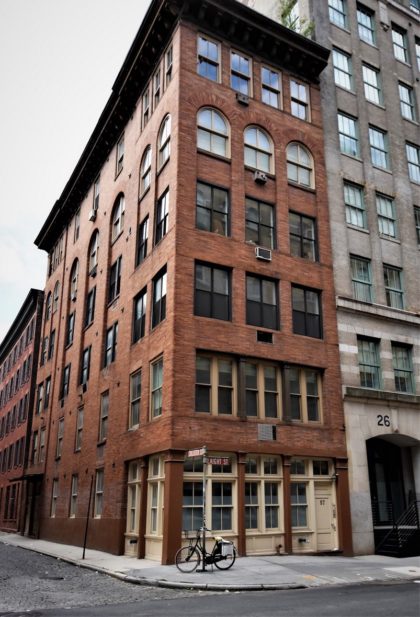 57 LAIGHT
57 LAIGHT
Rather surprisingly in a neighborhood of freight warehouses and produce concerns, No. 57 Laight Street filled with glass and mirror dealers. In 1898, its tenant list included Schrenk & Co., “looking glass”; John Proessl, who also dealt in looking glasses; the United Bavarian Looking Glass Works; and Tritschler, Winterhalder & Co., “druggists’ glassware.” Their landlord was Anna Woerishoffer, whose husband, well-known stock broker Charles F. Woerishoffer, had died in 1886. His estate was valued at upwards to $4 million—a significant $105 million today. Anna generously used her wealth for public good. In January, 1910, for instance, she donated $100,000 to the German Hospital and Dispensary, and on October 24, 1911, was recognized by the Prussian Government for her “distinguished services in the field of social betterment.” She nevertheless retained possession of No. 57 Laight Street until 1912, when she sold it to the Denver Chemical Manufacturing Company. A tragic side note was that, despite Anna Woerishoffer’s selfless philanthropies and social work, she became a victim of the anti-German sentiment that swept America during World War I. On March 20, 1918, according to Internal Revenue Service documents, she was “held to be a German subject, and an alien enemy.”
·························
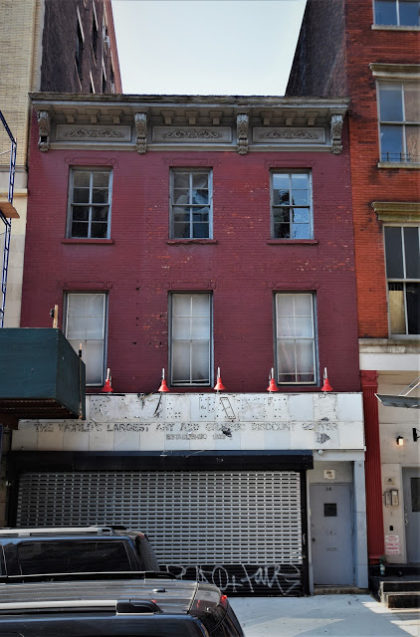 58 LISPENARD
58 LISPENARD
In 1833, Piero Maroncelli had fled to New York from his native Italy where the poet, musician, and journalist had spent time in prison for founding a revolutionary newspaper. During his 12-year incarceration he developed a tumor on his leg. The New York Times later reported, “The prison barber hacked off the limb, and after months of suffering Maroncelli’s life was saved. His sentence was commuted, and he came to this country.” Listed in directories as “Professor Marconelli,” he had moved into the Lispenard Street house by 1841. In addition to teaching music, he wrote critiques for the New York Sunday Mercury and the New World, wrote several books, and published poems and musical compositions. Godey’s Lady’s Book described him as “irritable, frank, generous, chivalrous, warmly attached to his friends, and expecting from them equal devotion. His love of country is unbounded, and he is quite enthusiastic in his endeavours to circulate in America the literature of Italy.” He died in the Lispenard Street house on August 1, 1846. Exactly one month later, the New-York Daily Tribune chastised Italian-born New Yorkers for their lack of a proper display of respect. If the newspaper was disappointed in the public display of respect at the time of Maroncelli’s death, it would certainly have approved of the massive ceremonies four decades later. Maroncelli’s casket was disinterred from Greenwood Cemetery in preparation for the return of his body to Italy to be buried with honors.
·························















